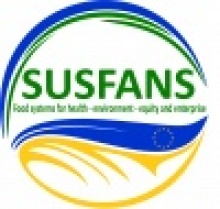Healthy and sustainable diets from a consumer perspective
The overall aim of Work Package 7 is to define “SHARP diets” for European (EU) consumers based on individual-level data. Such diets are environmentally Sustainable, Healthy (nutritionally adequate), Affordable (accessible yet also supporting the EU agri-food sector), Reliable (safe and stable in their supply), and Preferable (consistent with cultural norms and preferences).
Healthiness of diets
To be able to integrate these different domains we use foods as common denominator. The first aspect that we addressed is the healthiness (the ‘H’ of SHARP) of EU diets.
How do we define nutritional adequacy? Healthy diets can be based on dietary recommendations that combine minimum and maximum nutrient intakes, and food-based guidelines for some product categories, such as fruits and vegetables, red meat and fish intake.
The nutrient-based approach originally has a close link to health, growth and development, e.g., need of adequate intakes of both macronutrients (proteins, carbohydrates, and fats) and micronutrients (vitamins and minerals), whereas the food-based approach is closely linked to food consumption patterns, which are suggested to be strong predictors of health-disease outcomes.
Overall, food-based dietary guidelines may be regarded as a holistic approach that provide advice on foods, food groups and dietary patterns to provide the required nutrients to the general public to promote overall health and prevent chronic diseases.
Nutritional adequacy and consumption paterns
In the SUSFANS project we use a two-step approach to define nutritional adequacy of diets and food consumption patterns in EU countries.
The first step includes a set of food-based dietary guidelines and the second step includes a set of nutrients that are of concern in various regions of the EU.
Subsequently, by using this approach, the prevalence of inadequate intakes of a number of foods/food groups and nutrients in the European population can be investigated.
This has been described in a protocol (version 1.0) on nutritional adequacy (WP 2.2), which has been developed by the nutritional partners in the SUSFANS project (Czech Republic, Denmark, France, Italy, and the Netherlands).
Common food classification system
One of the main challenges is that we can only link the different domains if we use a common food classification system.
In SUSFANS we will make use of the FoodEx2 Exposure hierarchy from the European Food Safety Authority (EFSA) to consistently classify the food consumption data obtained from national food consumption surveys. This hierarchy consists of 4,311 food items structured in six levels with 21 groups at the top level, and is designed for exposure calculations of foods and food groups, hereby facilitating cross-country comparisons for the intake of foods and/or food groups.
Of the European Union, 22 member states have classified all the foods and beverages present in their national food consumption databases according to the FoodEx2 Exposure hierarchy. To link the other domains (the ‘S’ and ‘ARP’ of SHARP), we should use the same food classification system. Translation from other classifications systems to the FOODEX2 system will be one of the next steps in this project.


Comments
Add new comment